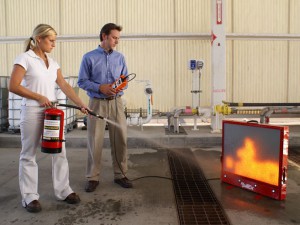-
May 20, 2019 by Total Fire and Safety

(Photo credit: Dreamstime ID 95654936 © Wavebreakmedia Ltd | Dreamstime.com)
With the rise in popularity and construction of senior living centers, fire safety continues to be a concern to keep our grandparents, parents, and aging loved ones protected. According to the United States Fire Administration, in 2015, older adults represented 15 percent of the U.S. population and suffered 40 percent of all fire related deaths. They are also 2.7 times greater risk of dying in a fire than the total population. Those 85 and older were 3.8 times more likely to die in a fire than the total population.
The elderly in multi-level dwellings are at higher risk of dying in a fire for several reasons. They may be on medication that impairs them from taking stairs down to safety, or their mobility issues may prevent them from moving quickly enough. They may live alone or have no one to call for assistance. Educating property managers, caretakers, and the elderly on fire safety for senior citizens is one step we can take in protecting this aging generation. Below are some considerations for property managers and their tenants.
1. Test Smoke Alarms
Smoke is a silent killer. Senior citizens with hearing problems who sleep without a hearing aid could be killed in their sleep. Having a working smoke alarm in every room and hallway helps, but they should be effective for the user. Strobe alarms are best, and seniors can install alarms that shake their bed to rouse them in the event of a fire. Most importantly of all, make sure to test smoke alarms every month so they are always in compliance.
2. Sit Your Butt Down…in the proper place!
Smoking is the number one cause of fire deaths in the country. Remind senior citizens never to smoke in bed and especially not near flammable oxygen tanks. Seniors can use deeper or heavier ashtrays to avoid ashes flipping or falling onto the rug and starting a fire. The best way to put butts out is with sand and water.
3. Create a Fire Escape Plan
Seniors may have less than three minutes to escape danger in the event of a fire. They should have a fire escape plan and practice it, knowing all the accessible exits. For seniors suffering from dementia or Alzheimer’s who have escape proof doors, it is important they have a prearranged escort in the event of a fire.
4. Stay in the Kitchen
Seniors should always stay in the kitchen when cooking. Most kitchen fires begin because food is left unattended, so if they must leave the kitchen while cooking they should turn the burner off. Even a short absence from the kitchen can unexpectedly turn into an extended amount of time away. If seniors must leave the kitchen, they should take a cooking utensil or potholder with them to serve a helpful reminder. Also, remind seniors to never cook with loose or dangling sleeves that can easily ignite and burn a senior, or potentially start a major fire.
5. Daily Necessities
Seniors should think about what they use to get around every day, like glasses, a wheelchair, a cane, etc. These items should be placed next to the bed for easy access in case of fire. A phone and a whistle should also be at bedside. The whistle lets people know where you are and enables you to warn others of the fire. Escape is always the priority; call the fire department later. If trapped, use the phone to call for help. Seniors with wheelchairs or walkers should check exit routes ahead of time to be sure they are accessible or plan an alternate route. Inform building managers or neighbors of the plan. If your impairment makes it impossible to escape in the event of a fire, discuss your concern with landlord, or check with the fire department.
6. Don’t Overload Outlets or Extension Cords
Inspect your extension cords regularly for fraying, exposed wire, or loose plugs. Unplug extension cords when not in use. If you need to plug in multiple appliances, use an extension cord approved by the Underwriter’s Laboratories (UL), a nationally recognized testing laboratory.
As their population begins to grow, fire safety for senior citizens cannot be stressed enough. Property managers, caretakers, the elderly, and their families should all be aware of the increased risk to the age group and try to protect them. The professionals at Total Fire and Safety are ready to help ensure your building has fire equipment that is working properly. We provide the life safety features that keep fire safety for your residents, including senior citizens, a main priority. Give us a call today! 630-960-5060
Category: Fire Alarm Monitoring, Fire exits, Fire Extinguishers, Fire Safety, Total Fire and Safety, Uncategorized Tags: fire and safety solutions, Fire Extinguisher, fire safety, fire safety solution, fire safety training, fire training, first aid, lifesafety, Total Fire and Safety, wireless fire alarm monitoring | Comments Off on Fire Safety for Senior Citizens
-
February 14, 2017 by Total Fire and Safety

If you visit the TFS headquarters in Woodridge, Illinois, make sure you take a look at our newly remodeled training room. Training is essential to what we do at Total Fire & Safety, not only for new employees but to help existing ones stay up-to-date on the latest hazards, fire codes and prevention techniques.
Our existing employees know the training room well. This is a picture of our fire extinguisher division meeting. Every month, each division of Total Fire & Safety, fire extinguisher, sprinkler, fire alarm and backflow, meet for monthly training and information exchange sessions. By gathering together, our team in each division can share information about their experiences in the field and discuss what is working or needs to be improved. Each division has their own concern with fire safety, so holding these division exclusive meetings is very helpful.
Who benefits most from these meetings? The TFS customer!
These meetings are one of many ways TFS is always trying to become more efficient and stay abreast of the latest in fire prevention and NFPA codes for their customers. The meetings help Total Fire & Safety deliver their very best in expertise, installation, maintenance and customer service to all our wonderful customers.
Thank you to all of our customers for making 2016 a great year for us. We promise to do everything we can as your commercial fire protection company to make 2017 a safe one for your commercial fire safety. If you have any questions about fire safety for your business or want to update your fire equipment going into the new year, don’t hesitate to contact us at 630-960-5060.
Category: Fire Safety, Total Fire and Safety Tags: fire professional training, fire safety training, fire training, Total Fire and Safety, total fire training | Comments Off on A New Year in TFS’s Commercial Fire Protection Training Room
-
April 13, 2016 by Total Fire and Safety

If your business has more than ten employees, they are going to need annual fire safety training. Some businesses rush to the least expensive program that will satisfy OSHA requirements, assuming that all training is the same; however, that’s simply not true. Fire safety training can vary in quality based on a number of factors, and many come with “hidden” fees that you may not be aware of. So what should you look for? Here are some important questions to ask before you book the training company.
1. What kind of course would you recommend? The course you need for your company should address the most probable emergencies that can occur at your facility. A training company worth its salt will tailor the course to your needs, surveying your business ahead of time to determine the most important content needed for your employees.
2. Who is teaching the course? Make sure the instructors are experienced professionals who know what real emergencies are like and how they occur. It’s even better if the instructor has experience with real-life emergencies. Nothing compares to the knowledge of a first responder who has faced countless fires and hazardous events. They can share personal stories, anecdotes and examples related to the training, which can make the class more interesting.
3. What will the course cover? Basic training courses cover how to use the fire extinguisher, but the most important thing employees should learn is WHEN to use the fire extinguisher. A good training course will focus on the importance of making fast and accurate, life-or-death decisions. Not only should your employees know how to fight fires, but also WHEN to fight the fire, and most importantly, when not to fight the fire. Evacuating and leaving it to the professionals is sometimes the best decision an employee can make.
4. Where will the training take place? Many fire safety trainings are performed outdoors, with a live burn in a pan that employees practice extinguishing. Although exciting, putting out a pan fire in a parking lot does not accurately simulate a realistic fire or emergency situation! Also, elements of the weather such as wind can affect the fire and unrealistically hamper the efforts of the employee trying to learn proper extinguishing techniques. It is much more effective to practice emergency procedures where they actually occur—inside the facility. With the help of digital technology, your employees can learn to extinguish the exact type of fire they would most likely face right at their worksite. This “on-the-spot” training also helps employees develop realistic evacuation plans and teach them to work as a team in an emergency situation.
5. Will there be extra costs involved with the equipment or the course materials? If the trainer is using “live burns”, or actual fires to practice extinguishing, you will need to have a burn permit and may incur any associated costs with setting up an outdoor space needed for the demonstration. If the training company uses your fire equipment for a live burn session, you will have to recharge them. You may not have budgeted for this unexpected, volatile cost, and it will vary based on how many turns each participant receives to extinguish the fire. The fire safety courses offered by Total Fire & Safety use high-tech, virtual simulators to practice extinguishing fires, which are versatile and allow more practice for each participant. These simulators feature virtual fire on a screen that responds realistically to the participant’s motions with the fire extinguisher. The indoor training gives each person multiple attempts with a full extinguisher every time until they feel confident with their firefighting skill. Compared to outdoor training, simulated training is more cost effective, accurate, completely green, and requires no messy clean-up or permit fees.
So before booking a company to perform fire safety training for your employees, ask these questions to make sure you receive your money’s worth for your employees and your business. No one can predict how an emergency will unfold, but the right training company can make sure your employees are not only prepared to fight a fire, but are adept at making quick decisions about whether or not it is safe to do so. For more information, contact the professionals at Total Fire & Safety at 630-960-5060.
Category: Fire Extinguishers, Fire Extinguishers, Fire Safety, Total Fire and Safety Tags: employee training, Fire Extinguisher, fire safety, fire safety training, fire training, fire training technology | Comments Off on Five Important Questions to Get Your Money’s Worth from Fire Safety Training
-
February 26, 2016 by Total Fire and Safety
 You may think you know the importance of first aid and fire safety, but the real impact of first aid and fire equipment training in the workplace is often overlooked. Whether your business is a high or low-risk environment, there are always risks that can lead to medical emergencies. You may think you know the importance of first aid and fire safety, but the real impact of first aid and fire equipment training in the workplace is often overlooked. Whether your business is a high or low-risk environment, there are always risks that can lead to medical emergencies.
1. Increasing profitability. A safer workplace means less missed workdays due to injuries. According to the National Safety Council, in 2012, nearly 5 million workers were injured at work, which costed employers a total of $198.2 billion.
2. Saving your employees time and money. It is proven that businesses and employees will save money if accidents are handled quickly and effectively. The National Safety Council attests that 25 percent of all emergency room visits can be avoided with basic first aid and CPR certification.
3. It really does save lives. If your employees don’t know how to handle injuries, the condition of the victim could worsen before the ambulance arrives, and cause further trauma and debilitation, not to mention medical costs and possibly, even death. Having a commercial first aid kit on the job sends a message to your employees that you value their health and well-being and are doing all you can to mitigate any injuries that occur on the job. It also shows that you never want your employees to be vulnerable to unattended injury.
4. It is required by law for many workplaces. The Occupational Safety and Health Administration requires businesses to provide first aid and CPR training to employees if there is no nearby clinic or hospital. Make sure you also have a commercial first aid kit available in your workplace. Obviously, if your business deals with risky materials or conditions, having a commercial first aid kit makes sense whether or not you are bound by law.
5. Teach your employees how to use emergency equipment. You spend money keeping your workplace up to code with commercial fire extinguishers and first aid kits, but these things don’t handle emergencies by themselves! Your employees need to know how to work fire extinguishers and use first aid supplies correctly. The investment need not be costly; a simple on-site class with the staff in attendance should suffice.
Total Fire & Safety can handle all your needs whether it be fire extinguishers, first aid kits, fire extinguisher training, or first aid training. For more information, visit our website or you can contact us at 630-960-5060.
Category: Fire Extinguishers, Fire Safety, First Aid Kits, Total Fire and Safety Tags: fire safety training, fire training, first aid, first aid kit, first aid training, training | Comments Off on Five Reasons Why Employees Should Have First Aid Training
|

|
|
|
|
|
|

 Facebook
Facebook
 Instagram
Instagram
 LinkedIn
LinkedIn



